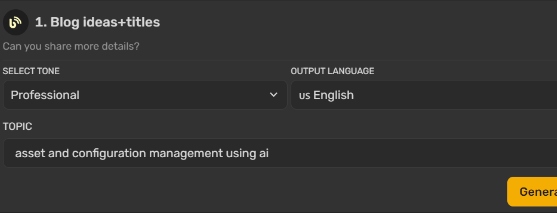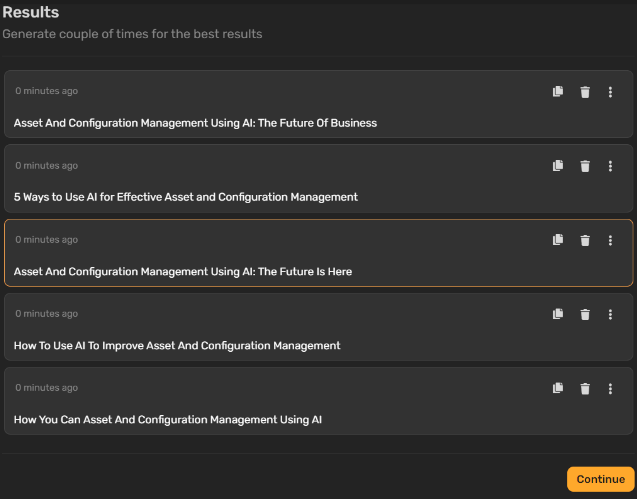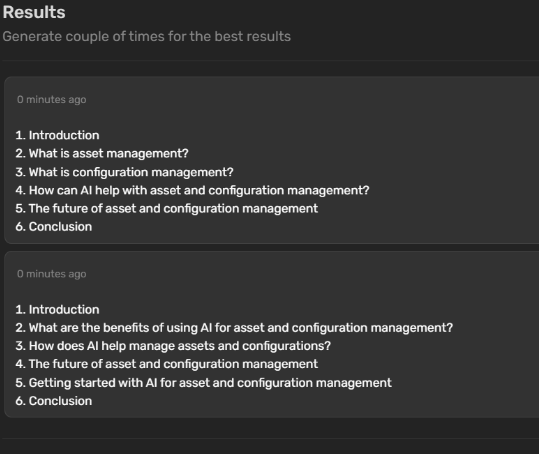Date Published March 9, 2023 - Last Updated February 20, 2024
 If this blog seems different than my usual content, please scroll down to the end of the article for surprise content about how I created it.
If this blog seems different than my usual content, please scroll down to the end of the article for surprise content about how I created it.
Introduction
The role of asset and configuration management (ACM) has historically been to ensure the stability and reliability of an organization’s IT infrastructure. However, with the advent of artificial intelligence (AI), ACM is evolving into a proactive management function that can help organizations avoid issues before they occur.
In this blog post, we’ll explore how AI is being used in ACM today and how it can be used even more effectively in the future. We’ll also discuss some of the challenges that need to be addressed before AI can be fully leveraged in ACM.
What Are the Benefits of Using AI for Asset and Configuration Management?
The most obvious benefit of using AI for SACM is the potential for improved performance. AI-driven models can identify correlations in data sets that are difficult or impossible for human analysts to see. This can help organizations predict outcomes and make better, more informed decisions about their IT environment. AI can also help organizations automate routine tasks, freeing up resources and personnel to focus on higher value activities. AI driven systems can evaluate hundreds, if not thousands, of systems simultaneously, allowing IT departments to identify problems quickly, look for patterns and trends, and generate reports faster than ever.
How Does AI Help Manage Assets and Configurations?
AI is used in SACM to analyze data from a variety of sources, including logs, hardware configurations and software configurations. This data is then evaluated to identify potential problems or misconfigurations. AI-driven systems can also be used to monitor system performance in real-time and to provide predictive analytics. This can help organizations identify potential problems before they occur, allowing them to prevent outages and other disruptions. AI can also be used to automate mundane tasks such as system configuration. It can do this by examining existing configurations and comparing them to known best practices. This can help organizations ensure that all systems are configured optimally, thus improving performance and reliability.
The Future of Asset and Configuration Management
The use of AI in SACM promises to revolutionize the way IT departments manage their infrastructure. AI-driven systems can provide deeper insights into system performance, allowing organizations to proactively identify and address potential problems before they become major issues. AI can also be used to automate mundane tasks such as system configuration, freeing up personnel for higher value activities. The use of AI in SACM is still relatively new, and there are some challenges that need to be addressed before it can be fully leveraged. AI systems require large amounts of data to be effective, and collecting this data can be difficult, particularly in large, tangled systems.
Additionally, the algorithms used by AI systems can sometimes be difficult to interpret, making it hard to determine how recommendations were made.
Getting Started With AI For Asset and Configuration Management
The first step to using AI in SACM is to gather and organize the necessary data. This can include system logs, hardware configurations, software configurations and other relevant data points. Once the data has been gathered, it needs to be structured in a format that can be analyzed by an AI system. This typically involves cleaning and normalizing the data to a common format. The next step is to create an AI-driven model to analyze the data. This process can involve using existing models or building custom models from scratch. Once the models are in place, they can be used to monitor system performance, identify correlations and automate routine tasks.
Conclusion
AI is poised to revolutionize service asset and configuration management. AI-driven systems can analyze vast amounts of data quickly and accurately, allowing organizations to identify potential problems before they become major issues. They can also automate mundane tasks such as system configuration and free up personnel for higher value activities. However, the use of AI in SACM is still relatively new and there are some challenges that need to be addressed before it can be fully leveraged. With the right data, models, and tools, organizations can begin to realize the benefits of AI for SACM.
In addition to having some apparent content errors and approximately 37 errors flagged by Grammarly, this blog seems a bit high-level and repetitive to me.
Working with our editor, Craig Idlebrook, I used this month’s topic for fun with our readers. I used AI to generate a blog about AI-assisted service asset and configuration management. Let’s look at the process and the blog I wrote before generating the AI content. My opinion is that while AI can be used to speed up a first draft of a blog, an expert still needs to add information only an expert would know and clean up the language.
Here's my methodology:
I’ve tried to access ChatGPT several times, receiving a beautifully crafted message about their capacity issues, so I found this SEO Content writing AI generator: https://app.simplified.com/ai-writer/
After logging in with my Google account, I configured the “create a blog” screens as follows:

The following article titles were provided:

I thought the third one down was closest to the blog I would have written from scratch, so I selected that one.

Again, looking at the options, I wanted something beyond the basics, that focused on the AI aspects of asset and configuration management, so I selected the second outline.
When I was prompted for keywords, I used these: Asset Management, Configuration Management, AI, Artificial Intelligence, Proactive Management.
The AI engine provided two introductions for me to choose from:
Introduction 1: Asset and Configuration Management (ACM) is a process used by organizations to manage their physical and virtual assets. These assets can include anything from hardware and software to people and processes. The goal of ACM is to ensure that all assets are properly configured and accounted for, so that they can be used to their full potential.
In the past, ACM was a manual process that was time-consuming and often error-prone. However, with the advent of artificial intelligence (AI), ACM is becoming more efficient and proactive. AI-enabled ACM solutions can help organizations save time and money, while improving the accuracy of their asset data.
Read on to learn more about how AI is revolutionizing the field of ACM!
Introduction 2: The role of asset and configuration management (ACM) has historically been to ensure the stability and reliability of an organization’s IT infrastructure. However, with the advent of artificial intelligence (AI), ACM is evolving into a proactive management function that can help organizations avoid issues before they occur.
In this blog post, we’ll explore how AI is being used in ACM today and how it can be used even more effectively in the future. We’ll also discuss some of the challenges that need to be addressed before AI can be fully leveraged in ACM.
I chose the second option, as once more, it was closer to my thought leadership style. I noted that Grammarly tagged two phrases for removal (highlighted). I would have left the first but deleted the second. I would also use the acronym SACM, as it’s the proper one for our audience. I made the Service Asset and Configuration Management (SACM) change in the intro and then generated the rest of the blog. You’ll note that it began picking up the use of SACM later in the blog.
Now, here’s mine! I hope you’ll agree that the one written by an industry thought leader has more meat: while the AI engine danced around how AI helps build the CMDB and provide proactive support, my own blog has the depth and examples you typically see in my writing. So while I could use the AI generator to create a good outline and some basic text to get started, I would still need to clean up the writing and add depth. I could probably save 15-20 minutes on a 750-word blog.
I used, but rewrote, the introduction to correct the errors and fix the grammar, and then used the outline with some of my own headings to create the rest of the content.
Service Asset and Configuration Management Using AI: The Future is Here!
By Phyllis Drucker
The role of service asset and configuration management (SACM) has historically been to ensure the stability and reliability of an organization’s IT infrastructure. However, with the advent of artificial intelligence (AI), ACM is evolving into a proactive management function that can help organizations avoid issues before they occur.
In this blog, we’ll explore how AI is being used in ACM today and how it can be used even more effectively in the future. We’ll also discuss some challenges that need to be addressed before AI can be fully leveraged in ACM.
The Benefits of SACM
Despite the availability of discovery tools and the focus of the CMDB as a core component of a mature service management practice, many organizations have still not adopted SACM because of the perceived complexity and expense. While they may have built an asset repository for financial and control purposes, they will continue to struggle to deliver proactive support and lower operational risk until they do. Using discovery and monitoring tools, along with error logs as data inputs for a mature configuration management practice, organizations can achieve many of the following benefits:
- Provides improved awareness of the components needed to operate a business service, making it possible to prioritize issues and alert the appropriate support teams when a component fails.
- Recognizes devices that are not configured, patched, or updated to corporate standards, then address those shortcomings with automated patch management and ticket generation for those that cannot be automated.
- Secures the enterprise by ensuring appropriate patch and software levels and using the combination of monitoring tools and expected transactions to identify anomalies that might indicate incidents or security intrusions.
- Secures the enterprise by ensuring only authorized devices can connect to network resources.
- Lowers the risk of deploying changes by alerting technicians to conflicts and configuration information needed to do so safely. Risk is also lowered by using AI in combination with this information to identify similar failed changes.
- Increases the ability to identify potential equipment failures and alert technicians automatically.
AI Can Help Build and Maintain the CMDB
AI bridges the gap between discovery and monitoring rules by enabling technicians to complete configuration information and then use that information to ensure that all devices are properly maintained and managed. For example:
- Duplicate devices can be flagged for review and/or eliminated automatically.
- Devices with incomplete configuration can be flagged for attention.
- Transaction flows between devices and applications can assist with automated service mapping.
- Pattern mapping algorithms and rules can assist with automated service mapping.
- Device health (patch and software levels and configuration) can be monitored and flagged for attention when it doesn’t meet expected configuration requirements.
AI helps with the 80/20 rule: with AI performing the heavy lifting that prevents many organizations from building their CMDB, technician efforts can be used to manage the exceptions using dashboards to handle the most critical issues first. The use of automation helps scale the effort, helping make it more attractive to management.
The Future of Asset and Configuration Management: By increasing the ease of adopting SACM and enabling automated proactive management of equipment, AI will lower the entry barriers for many organizations and provide a strong business case for investing in the tools needed to do so. This will increase the adoption rate of SACM and continue to improve the use cases for AI in technology.
Getting Started with AI
To start using AI for SACM, many organizations can look no further than their current service management platforms. Many already have AI features built-in for managing CMDB data: health dashboards, duplicate registers, service mapping, and CMDB management features that help display and manage exceptions. Integrating patch management and vulnerability management suites with the service management functions can also help organizations tie their SACM practice together with proactive device and security vulnerability management to realize the benefits raised in this article. Many of these tools already have AI algorithms and policy generators that enable organizations to adopt AI for configuration management quickly and easily.
Conclusion:
It’s no longer acceptable to operate without the benefits of SACM, and AI will help many organizations get there. While investment in discovery and monitoring tools may be needed to address everything in this blog, there are business cases that organizations can leverage to get the funding they need. Many fall in the area of securing the enterprise and improving the employee experience:
- Improved security vulnerability management
- Improved intrusion detection
- Proactive management of network devices
- Lowered device failure rate, lowered service interruptions
Organizations should use the benefits to help build their business case and justify the return on investment in the tools needed to leverage a robust CMDB to improve operations.
Phyllis Drucker is a professional speaker, blogger, and writer.